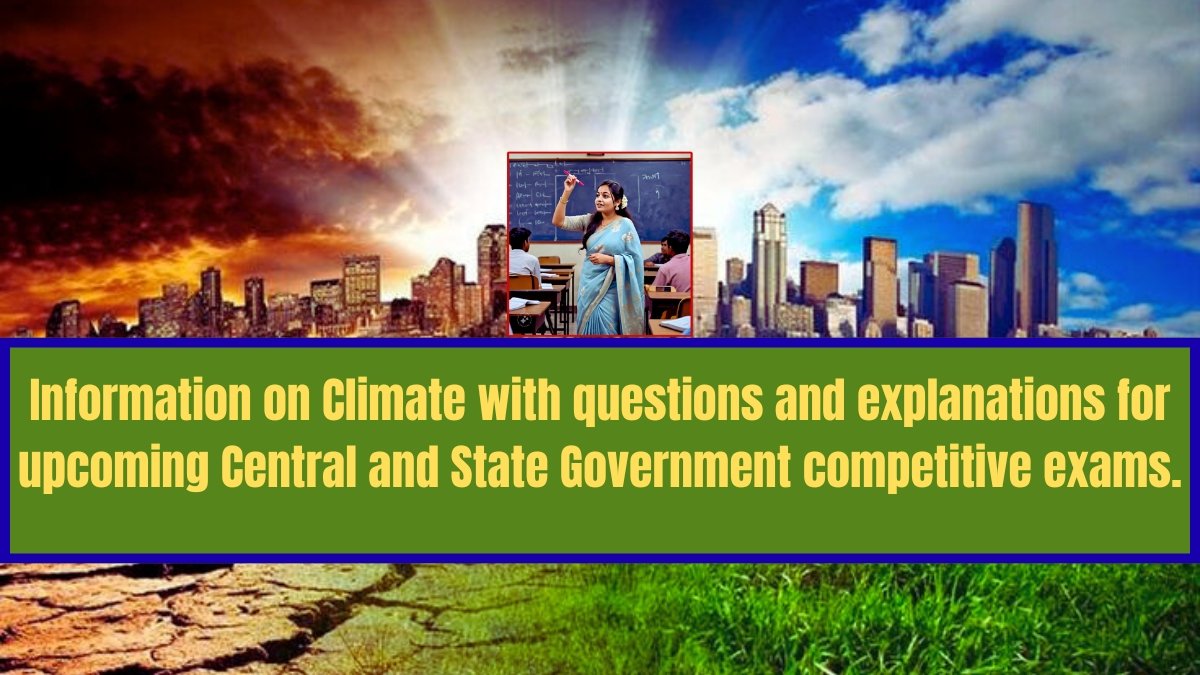Climate: Information on Climate with questions and explanations for upcoming Central and State Government competitive exams.

1. Which one of the following is the driest region in India?
1) Telengana
2) Marwar
3) Vidarbha
4) Marathwada
Ans:-2) Marwar
• Marwar is a region in the southwestern state of Rajasthan in western India.
• It is partly located in the Thar Desert, the driest region of India.
• It includes the present-day districts of Barmer, Jalore, Laxman Nagar, Jodhpur, Nagaur and Pali.
• This desert is nicknamed Marwar or the land of death.
• The region with the lowest rainfall in India: Ruili, Rajasthan.
• Least rainfall in Karnataka: Nayakanahatti in Chitradurga district,
• Highest rainfall in India: Mawsynram (1141 cm) in Shimoga district of Meghalaya state.
• Heaviest rainfall in Karnataka: Hulikal, Agumbe.
• The driest place on Earth: Atacama, Chile
————————————————————————–
2. The Tamil Nadu coast gets a large portion of its total rain during
1) March to June
2) June to September
3) October to November
4) November to February
Ans:- 3) October to November
• Withdrawal period of the southwest monsoon winds (mid-September to mid-December): This period is called the northeast monsoon season.
• The coast of Tamil Nadu (Coromandabhandal Coast) receives most of its annual rainfall from the northeast monsoon during the October–December period.
• It started in mid-September and extended until November.
• This rainy extension of the normally returning monsoon is called the northeast or winter monsoon.
• The northeast winds, carrying moisture, cause rainfall along the Coramanda coast due to the shape and barrier of the coastline.
• India receives 13% of its annual rainfall during the northeast monsoon.
————————————————————————–
3. Rainfall occuring in hot weather known as ‘Mango Shower’ in
1) Rajasthan
2) Assam
3) West Bengal
4) Kerala
Ans:-4) Kerala
• Summer or hot weather season [March to the end of May]
• During this season, the sun’s rays slowly shift from south to north, moving from the Tropic of Capricorn towards the Equator, causing temperatures to rise. During this season, some parts of India receive moderate rainfall.
• This rain is known locally as: in Kerala: Mango Showers, in Karnataka: Coffee Showers & Cherry Blossoms, in West Bengal: Kalabaisaki, in Assam: Tea Showers.
• This period of rain is called the pre-monsoon period.
• The country receives 10% of its annual rainfall during the summer period.
• This period is the time for necessary preparations for the onset of the southwest monsoon winds.
————————————————————————–
4. How is the climate of India described?
1) Monsoon type
2) Equatorial type
3) Tundra type
4) Mediterranean type
Ans:-1) Monsoon type
• (1) The word Monsoon is derived from the Arabic word ‘Mousim’, which means ‘period’.
• In meteorology, the term monsoon is used to describe the winds blowing in opposite directions from the earth’s surface up to a height of 20 km following the equinox.
————————————————————————–
5. The burst of monsoons in the month of June brings rain to
1) Kerala and Karnataka
2) Kerala & Southern coast of Tamil Nadu
3) Kerala, Tamil Nadu and parts of Andhra Pradesh
4) Kerala, Tamil Nadu and Karnataka
Ans:- 2) Kerala & Southern coast of Tamil Nadu
• The onset of monsoon in the month of June brings rains to Kerala and the southern coast of Tamil Nadu.
• These trade winds in the Southern Hemisphere deviate and become the southwest monsoon winds after crossing the equator.
————————————————————————–
6. Which of the following is the area of lowest pressure over Indian subconti-nent during the hot dry weather season?
1) Rann of Kachchh
2) Rajasthan
3) North-West India
4) Meghalaya
Ans:- 3) North-West India
• During the summer season, the Thar Desert, the northern and central Indian subcontinent, becomes considerably hotter during the hot summer months. This creates a low pressure area over the northern & central Indian subcontinent.
• Moist air from the Indian Ocean rushes into the subcontinent to fill this low pressure area.
————————————————————————–
7. What is the period of cold weather season in India?
1) Mid-November to February
2) October to December
3) November to January
4) December to March
Ans:- 1) Mid-November to February
• Generally, cold weather starts in mid-November and continues until February.
• Coastal areas have moderate temperatures throughout the year.
• Generally, temperatures decrease from south to north.
• Winter in India is a period of very low temperatures, very low rainfall, and very few thunderstorms.
• Usually, during this period, fog forms in the morning due to the inversion of temperature.
• Cyclones form in the Mediterranean Sea and cross Iran, Afghanistan, and Pakistan before entering the northwestern part of India.
• India receives only 2% of its annual rainfall in winter.
• Winter is the season of least rainfall in India.
• This rain is very suitable for the Rabi crop.
————————————————————————–
8. If 20% or more area of the country suffers from rain deficits during monsoon season, it is termed as
1) Flood year
2) Drought year
3) Famine year
4) Self sufficient year
Ans:- 2) Drought year
• According to the India Meteorological Department, if the rainfall deficit for the country as a whole is more than 10% above normal and more than 20% of the country’s area is affected by drought conditions (rainfall deficit), such a situation is defined as an All India Drought Year.
• If rainfall is less than 75% of the annual average rainfall, it is called an extreme drought.
• The Meteorological Department describes a moderate drought as a 25 to 50 percent reduction in annual rainfall, while a more than 50 percent reduction in annual rainfall is considered a severe drought.
————————————————————————–
9. What is the major cause of October Heat’?
1) Hot and dry weather
2) Very low velocity winds
3) Low pressure systems over the Indo-Gangetic plains
4) High temperature associated with high humidity
Ans:- 4) High temperature associated with high humidity
• The months of October-November mark the transition period from hot rainy season to cold dry winter conditions.
• (The Retreating Monsoon Season) or transitional period is called. Because during this period the southwest monsoon weakens. Then the southwest monsoon retreats or retreats from India. This phenomenon is called ‘October Heat’.
————————————————————————–
10. Why does the west coast of India receive more rainfall from southwest monsoon than the east coast?
1) Unlike the east coast this coast is straight
2) The Western Ghats obstruct the winds causing rainfall
3) The east coast is broader than the west coast
4) The Eastern Ghats extend parallel to wind direction
Ans:- 2) The Western Ghats obstruct the winds causing rainfall
• The western side of the high mountain ranges of the Western Ghats block the southwest monsoon winds.
• This will result in more rainfall in the western hills.
• During the southwest monsoon, India receives rainfall from the Bay of Bengal branch and the Arabian branch.
• The Arabian Sea branch hits the western and southern parts of India, while the Bengal branch brings rain to the northeastern states. The Arabian Sea branch carries twice the water content of the Bay of Bengal branch.
• The southwest monsoon winds coming from the Arabian Sea branch are blocked by the Western Ghats, which run like a wall from north to south along the west coast of India, causing orographic rainfall.
• The rainfall is highest in the southern part of the Western Ghats and decreases towards the north. The eastern part of the Western Ghats is called the “rain shadow region”.
• India receives 75% of its rainfall during the southwest monsoon, and 90% of the country’s total area receives rainfall, transforming it into the monsoon (kharif) crop season.
• Bay of Bengal Branch:- These winds pick up moisture as they blow from the Bay of Bengal and move towards the east coast, eventually reaching the northeastern mountain ranges.
• Because its reservoir is lower than the Arabian Sea, the west coast of India receives more rainfall from the southwest monsoon than the east coast.
————————————————————————–

11. Though there is no single theory which can explain the origin of south west monsoon, however it is believed that the main mechanism is the differential heating of land and sea during:
1) Winter months
2) Summer months
3) Cyclonic storms
4) South-west trade wind flow
Ans:- 2) Summer months
• According to the thermal theory, during the hot subtropical summer, the vast land area of the Indian peninsula heats up at a different rate than the surrounding seas.
• This results in a pressure gradient from south to north.
• This causes a flow of moist air from the sea to the land. When this moist air reaches the land, it slowly rises and cools due to geographical features. This leads to orographic rainfall known as the southwest monsoon.
————————————————————————–
12. Which of the following causes rainfall during winters in the north-western part of India?
1) Western disturbances
2) Cyclonic depression
3) Southwest monsoon
4) Retreating monsoon
Ans:- 1) Western disturbances
• Western Disturbance (WD): Northwest India is subject to the influence of the tropical cyclones during the winter season.
• During this period, the polar front will shift southward and will be at 35-40° north latitude. This will bring the Mediterranean Sea region under the influence of these cyclic winds.
• Western Disturbances: These are storms that originate in the Caspian or Mediterranean Sea and, according to the India Meteorological Department (IMD), bring non-monsoon rainfall to northwest India.
• This is called an “Extra-tropical Storm”. The reason is that the winds are moving from the west to the east (Westem).
• Disturbance:- means ‘disturbed’ or reduced air
• Pressure area. [Air moves from high pressure to low pressure area]
• “Extra tropical cyclone” means Western Disturbances: This term is used because they originate outside the tropics. Overall, Western Disturbances bring winter and pre-monsoon rains and are conducive to the growth of the Rabi crop in northwest India.
————————————————————————–
13. The Daily Weather Map of India is prepared and printed at
1) Kolkata
2)Mumbai
3) New Delhi
4) Pune
Ans:- 4) Pune
• The daily weather map of India is prepared and printed at the National Data Centre of the India Meteorological Department (IMD) in Pune.
• Daily weather reports and daily weather maps of India in printed form have been available since 1878.
• IMD-India Meteorological Department :- This is a branch of the Ministry of Geology.
• Established:- 1875, Head Office – New Delhi, Regional Offices: Chennai, Mumbai, Kolkata, Nagpur, Guwahati and New Delhi.
• Headquarters in 1875 – Calcutta
• Headquarter was transferred to Shimla in 1905.
• Head office transferred to Pune in 1928.
• In 1944, he was transferred to the Central Office – New Delhi.
• The Indian Meteorological Department became a member of the “World Meteorological Organization” from 27th April 1949. Its headquarters are in Geneva, Switzerland.
————————————————————————–
14. Around the arrival of monsoon, the normal rainfall increases suddenly and continues constantly for several days. This is known as the——of the monsoon.
1) Closure
2) Hit
3) Burst
4) Peak
Ans:- 3) Burst
• The trade winds of the Southern Hemisphere deviate after crossing the equator and become the southwest monsoon winds.
• The southwest monsoon enters India as the Arabian and Bengal branches and spreads across India.It rains.
• The Malabar coast of the state of Kerala in India receives the first rains of the southwest monsoon in early June. This first rain is called the “out burst” of the monsoon.
————————————————————————–
15. Which one of the following states receives the highest rainfall during winter months?
1) Mizoram
2) Uttarakhand
3) Tamil Nadu
4) Bihar
Ans:- 3) Tamil Nadu
• India receives 13% of its annual rainfall during the monsoon season.
• Coastal Tamil Nadu receives 50% of its annual rainfall during this period.
• Northeast Monsoon (winter rains): The Intertropical Convergence Zone (ITCZ) is at 100°S during this period. Due to this, winds blow from northwest to northeast across the North Indian Plains to the Bay of Bengal and from north to south within India.
• The high-pressure winds from Central Asia, blocked by the Himalayas, turn eastwards towards Myanmar and then merge with the trade winds from South China to form the northeasterly winds, bringing rain to the Bay of Bengal coast, including Tamil Nadu, Andhra Pradesh, and parts of Karnataka and Kerala. The states of Tamil Nadu and Andhra Pradesh receive 80% of their annual rainfall during this period.
————————————————————————–
16. Which of the following regions is not affected much by the Arabian sea branch of Monsoon ?
1) Madhya Pradesh
2) The western ghats
3) Deccan plateau
4) Chattisgarh basin
Ans:- 1) Madhya Pradesh
• Monsoon:- The period of southwest monsoon winds (June to September) is called the rainy season. During this period, India receives 75% of its annual rainfall. During this period, the rainfall is divided into Arabian Branch & Bay of Bengal Branch for India.
• The Arabian branch of the monsoon brings rain to the Western Ghats and the Deccan Plateau. The winds from the Bay of Bengal blow from the water towards the land of India due to the difference in air pressure. As these winds blow from the Bay of Bengal, they pick up moisture and move towards the east coast and finally reach the northeastern mountain ranges.
• The winds from the Arabian Sea and the winds from the Bay of Bengal combine to blow towards the northeastern region of India. The Himalayan mountain ranges and the North Eastern Ghats and hills intercept the winds and bring heavy rainfall to Mawsynram and Cherrapunji in the Nookrek region of the Meghalaya plateau.





